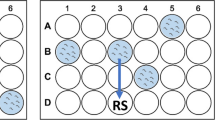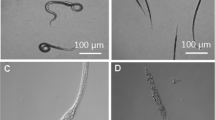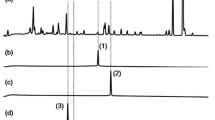Abstract
Effects of nutrients and growth temperature on the production of an extracellular protease fromXenorhabdus nematophilus, a symbiotic bacterium of entomopathogenic nematodes were studied for batch culture. Tryptone and fructose were most effective nitrogen and carbon sources to produce high level of the protease within 24–28 hr of incubation. The stability of protease was poor during the incubation of the bacteria. The protease activity increased in parallel with cell growth then decreased significantly for extended culture periods of the bacteria over 48 hr at 22–30°C. Autolysis of the protease was not a major cause for the decreased protease activity since no decrease in the protease activity was observed for the whole culture broth of the bacteria which was stored up to 80 hr at 4°C.
Similar content being viewed by others
References
Park, S. H. and D.W. Kim (1997) Environmentally friendly biopesticide using entomopathogenic nematodes.Kor. J. Biotechnol. Bioeng. 12(3): 261–268.
Georgis, R. (1992) Present and future prospects for entomopathogenic nematode products.Biocontrol Sci. Technol. 2: 83–99.
Schmidt, T. M., B. Bleakley, and K. H. Nealson (1988) Characterization of an extracellular protease from the insect pathogenXenorhabus limunescens, Appl. Env. Microbiol. 54(11): 2793–2797.
Akhurst, R. J. (1980) Morphological and functional dimorphism inXenorhabdus spp., bacteria symbiotically associated with the insect pathogenic nematodesNeoaplectana andHeterorhabditis.J. Gen. Microbiol. 121: 303–309.
Wang, H. and B. C. A. Dowds (1993) Phase variation inXenorhabdus luminescens: cloning and sequencing of the lipase gene and analysis of its expression in primary and secondary phases of the bacterium.J. Bacteriol. 175(6): 1665–1673.
Smigielski, A.-J., R. J. Akhurst, and N. E. Boemare (1994) Phase variation in Xenorhabdusnematophilus andPhotorhabdus luminescens: differences in respiratory activity and membrane energization.Appl. Environ. Microbiol. 60: 120–125.
Bowen, D., T. A. Rocheleau, M. Blackburn, O. Andreev, E. Golubeva, R. Bhartia, and R. H. Ffrench-Constant (1998) Insecticidal toxins from the bacteriumPhotorhabdus luminescens.Science 280: 2129–2132.
Park, S. H. and Y. S. Yu (1999) Isolation and culture characteristics of a bacterial symbiont from entomopathogenic nematodeSteinernema glaseri.Kor. J. Biotechnol. Bioeng. 14(2): 198–204.
Park, S. H. and Y. S. Yu (1999) Isolation and identification of a symbiotic bacterium fromSteinernema carpocapsae.Biotechnol. Bioprocess Eng. 4(1): 12–16.
Author information
Authors and Affiliations
Corresponding author
Rights and permissions
About this article
Cite this article
Ryu, K.G., Bae, J.S. & Park, S.H. Extracellular protease production fromXenorhabdus nematophilus, a symbiotic bacterium of entomopathogenic nematodes. Biotechnol. Bioprocess Eng. 4, 147–150 (1999). https://doi.org/10.1007/BF02932385
Issue Date:
DOI: https://doi.org/10.1007/BF02932385




